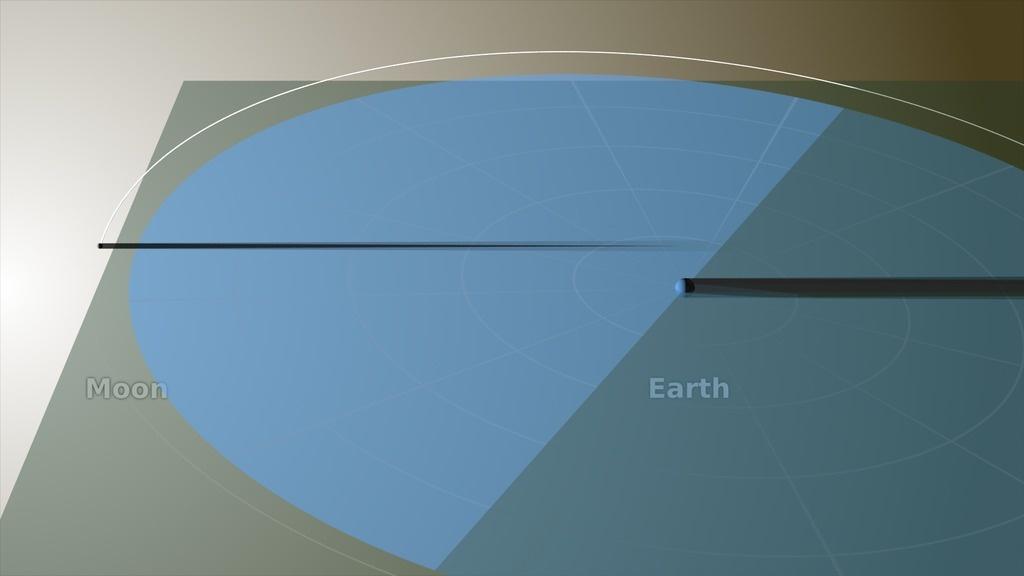
The moon’s shadow only hits the Earth when the line of nodes is pointed toward the Sun.
NASA’s Scientific Visualization Studio
On Sunday, March 10, at 09:00 UTC (5:00 a.m. EDT), our natural satellite will pass between the Earth and the sun. This new moon will be invisible, lost in the sun’s glare all day, only to emerge early next week as a slim crescent moon in the evening sky after sunset.
It does this every 29 days, but very rarely does it eclipse the sun. While March’s “New Worm Moon” will pass without comment, the next new moon—the “New Pink Moon”—will cause a solar eclipse visible across North America. Those lucky enough to get inside the 115-mile-wide path of totality will witness something very grand—a total solar eclipse.
Here’s why total solar eclipses do not happen every month:
The Ecliptic Explained
The sun’s path through the sky each day is called the ecliptic—the clue is in the name! This line from the eastern horizon to the western horizon represents the sun’s apparent path through Earth’s daytime sky. When the moon crosses that line, we get an eclipse—hence the name.
If the moon followed the ecliptic perfectly, we would expect to see both a solar and a lunar eclipse every month. It’s only when a new moon crosses the ecliptic that a solar eclipse can occur. Similarly, a lunar eclipse only happens when a full moon crosses the ecliptic.
The Moon’s Tilted Orbit
The moon orbits the Earth every month (moon-th!), so does a solar eclipse happen every month? No. The moon’s journey around Earth is bumpy, and the new moon usually misses the sun. That’s because its orbital path around Earth is tilted by five degrees with respect to the ecliptic.
However, despite its orbit being tilted, the moon must intersect the ecliptic twice each month. These two points on the ecliptic are called nodes. A solar eclipse occurs when the moon reaches its new phase while at one of these nodes. When a full moon does, the result is a lunar eclipse.
Eclipse Seasons
The moon reaches those two nodes—the ascending and descending nodes—at different times every month. Typically, it shows up at a node there when the sun is somewhere else so no kind of eclipse results. However, every 173 days—for between 31 and 37 days— the moon arrives at both of those nodes at the perfect time to cause an eclipse.
The result is a short season during which two—and occasionally three—solar and lunar eclipses can occur. Often, a slight lunar eclipse is followed by a slight partial eclipse, and that’s your lot. Eclipse season is over. In the coming eclipse season, however, a penumbral lunar eclipse—a near-miss where the moon reaches a node just too early to cause a total lunar eclipse—on March 25 will be followed two weeks later by a bullseye, April 8’s total solar eclipse.
The Moon’s Apparent Size
A total solar eclipse is only possible because the moon’s apparent size can be exactly the same as the apparent size of the sun. Add that to the fact that the moon crosses the ecliptic twice each month, and totality becomes possible.
On average, the sun is 400 times larger than the moon but also 400 times further from Earth. That’s the celestial coincidence that makes total solar eclipses possible, but another crucial factor is the distance of the new moon from Earth. The moon’s elliptical orbit means it varies in distance from Earth, from about 225,558 miles (363,000 kilometers) to 251,655 miles (405,000 kilometers).
If a new moon crosses the ecliptic while it is furthest away (apogee), an annular solar eclipse—commonly called a “ring of fire”—is the result. That’s pretty, but at no point does it get dark, nor can you take off your solar eclipse safety glasses. Only when a new moon occurs near its closest point to Earth (perigee) does it appear large enough to block the sun. Technically speaking, it’s something you’ve heard of in the media, though rarely about a solar eclipse—a supermoon.
‘Super New Moon Eclipse’
A new moon that occurs when the center of the moon is less than 223,694 miles (360,000 kilometers) from the center of Earth is a supermoon, according to Timeanddate. Its angular size is 12.5%–14.1% larger than the moon at its smallest and 5.9%–6.9% larger than average.
On April 8, the new moon at the point of greatest eclipse close to Nazas, Mexico, will be precisely 221,767 miles (356,900 kilometers) from Earth, according to AstroPixels, having been at perigee a few hours earlier. It will, therefore, appear slightly larger than the sun and, therefore, be capable of covering 100% of its bright face.
The path of totality on April 8, 2024.
Michael Zeiler/GreatAmericanEclipse.com
Path Of Totality
Here’s where you need to be inside the moon’s central shadow—its umbra—to experience darkness in the day and, if there’s a clear sky, to see the sun’s beautiful corona revealed:
- Mexico: Sinaloa, Nayarit, Durango, Coahuila and Chihuahua
- U.S: Texas, Oklahoma, Arkansas, Missouri, Illinois, Kentucky, Tennessee, Michigan, Indiana, Ohio, Pennsylvania, New York, Vermont, New Hampshire and Maine
- Canada: Ontario, Quebec, New Brunswick, Prince Edward Island, Nova Scotia and Newfoundland.
The result of all of these celestial mechanics, of course, will be a spectacular total solar eclipse, which won’t be seen again in North America until 2033 in Alaska and 2044 in the contiguous U.S.
For the latest on all aspects of April 8’s total solar eclipse in North America, check my main feed for new articles each day.
Wishing you clear skies and wide eyes.










